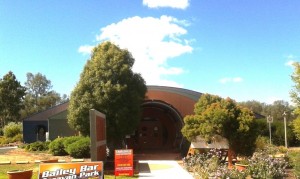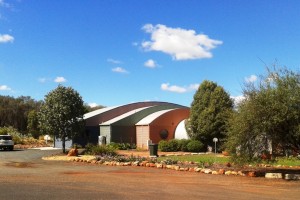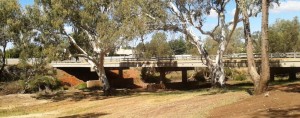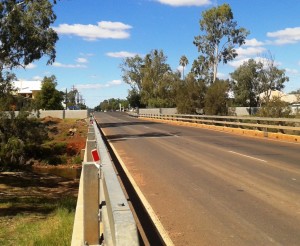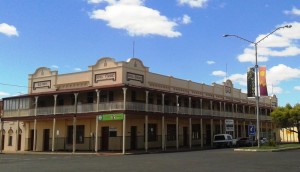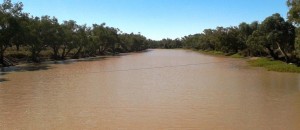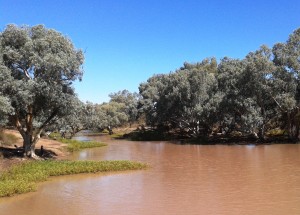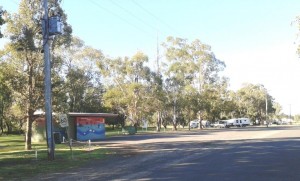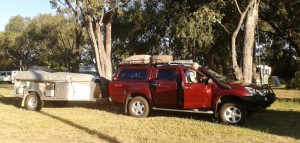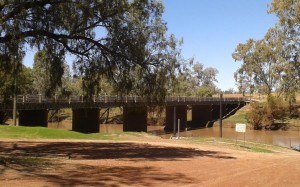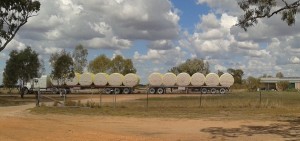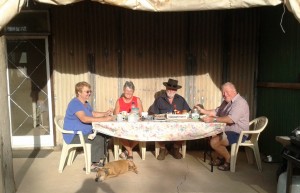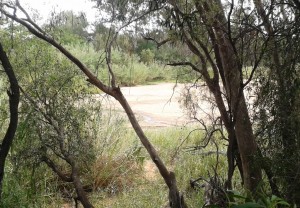Day 5 – 31st March 2013 – Charleville
At some point during the night I turned the air conditioner off and pulled up the doona. Rain had been falling all night. We awoke to a grey sky and weather reports that told us that it was 17C, half of yesterday’s temperature. Are we in Melbourne already?
We got a bit of a fright at lunch time. We turned on a second light and it came on very dimly. We then noticed that the lights had gone out on the refrigerator. Oh no! Not battery charger problems on a one year old van. Fortunately not! On our short test trip to check on our electrics for bush camps I had to replace a fuse. To get at the fuse box I had to unplug the battery charger … and forgot to plug it back in. So we had been living on charge put into the battery when moving since we left home. The battery had been progressively discharging. All seems well now.
Intermittent rain fell all day so we stayed in the warmth of the van and read, including tourist information in our reading. The forecast for tomorrow is for fine weather, so we will check the place out.
I guess you don’t normally think of a town facing in a particular direction but Charleville definitely faces south, because that is where the tourist money comes from. North Queensland has a wet season and a dry season. Charleville has a “Grey Nomad” season and a “Rest of the Year” season. Charleville is on the main route that Victorians and South Australians take when starting out on The Big Lap (around Australia). Most lappers do the lap in an anticlockwise direction.
Charleville Information Centre
Tourist authorities have marketed the town well. The Information Centre is on the Mitchell Highway to the south of the town. Most lappers do the around Australia lap anticlockwise so will only ever approach the town from the south. Their printed material is excellent, particularly the visitors guide that they produced annually. Activities are set out in detail with times, amount of time to allow and the cost. And most things have a cost. Some have a substantial cost. Perhaps they think that grey nomads have money running out of their pockets this early in the circumnavigation.
Cosmos Centre Building
Weather permitting we will look at some of these attractions for you, and us, tomorrow.
Day 6 – 1st April, 2013 – Charleville
Yesterday’s rain was followed by a fine sunny day so, after breakfast, we set off to see the town. We started at the Information Centre, located at the southern entrance to town. It is part of the Charleville Cosmos Centre, which in turn is the jewel in Charleville’s crown. The information centre is modern, contains a very pleasant coffee shop and all the information on other relevant destinations that you could want.
The Cosmos Centre is about looking into the heavens. Charleville normally has an abundance of clear skies so is ideal for things celestial. The main event occurs at night but there are a number of simulated activities, some of them interactive, that can be used in daylight hours to cater for those who don’t get to the evening show. For those who have an interest in such matters, or first timers, it is a great opportunity see the realms beyond.
Clement Wragg’s ineffective Vortex Rain Gun
From there we took a look at meteorologist Clement Wragg’s Vortex rainmaker guns that didn’t make rain and then took the Timber Walk to view samples of the trees and shrubs that grow in the area. As this was Easter Monday the town was closed but we walked the main street to get a feel for the town. All was quiet. Even the famed Hotel Corones was closed for business. The old lady is in need of much TLC but tours and after noon teas are available spasmodically now but will rev up as the southern tourists start to move through.
Two views of the bridge and flood barriers
Charleville floods regularly but now has a flood barrier along the banks of the Warrego River. But the town has that “what’s the use” look about it and could not be described as attractive. It is, in fact, quite down at heal.
Hotel Corones looking a little tired
After lunch we drive 20 km out of town to look at Ward River, a local fishing location. We found a body of water larger than the Warrego with fisher folk doing their thing.
Broad waters of Ward River
Fishing in the shade
When we came back to the park at lunch time, a sandwich board at the gate proclaimed a camp oven dinner to be available that evening, so we booked. The operators erected a marquee under which they set up metal open fire containers for cooking and ambiance. Attendees were required to bring a chair, plate, bowl and cutlery. The main meal was a large ladle of mashed potatoes covered with an even larger ladle of excellent beef stew with Johnny cakes made of damper mixture. Dessert was apple crumble with custard followed by genuine billy tea. Great meal and we met some great people.
Day 7 – 2nd April – Charleville to Mitchell – 181 km
With only about 180 km back to Mitchell we were able to make a leisurely start and cruised sedately along a road that we had almost to ourselves. The high point was refuelling at Morven.
Neil Turner Weir camping area
We located the free camp site at Neil Turner Weir and were set up in time for lunch. About an hour later Bruce and Annie arrived. We met this couple at St George last year. They would have been in the Mount Moffatt group but they are off on a four month trip to NT and The Kimberly. We have kept in touch but our paths crossing here gave an opportunity to catch up physically. We examined their new and well fitted Isuzu D-MAX Ute, had dinner and a chat around the camp fire and turned in with almost total darkness and near complete silence. There were probably twenty or so other campers there, but they were all quite as mice.
An early morning departure
Day 8 – 3rd April – Mitchell to St George – 283 km
Our original path from Mitchell was directly to St George but problems with the Wi-Fi function on our wireless broadband modem dictated that we return to Roma, as that is the only town in which we would find a Telstra shop. So, armed with a new 4G Wi-Fi modem that would fit in your pocket, we headed to St. George via Surat. The country is similar to that between Roma and Mitchell but flatter.
Surat, a name familiar to many from the Surat Basin gas fields, sits on the high bank of the Maranoa River from where its citizens can watch the fairly frequent floods. At the bridge plaques show photos of the river in flood with the tops of the street lights at waist height above the water.
An unflooded Maranoa River
We spent the night at the Pelican Rest Caravan Park at St George with not a pelican in sight.
Day 9 – 4th April – St George to Lightning Ridge – 230 km
The destination at day’s end was Lightning Ridge to call on another couple that we had met at St George last year and then called on at Lightning Ridge a few days later as we travelled south. Trevor and Margaret live near Murwillumbah in northern NSW but have a family cabin on an old opal mining lease that has been converted to a residential lease. It is in the scrub surrounded by the evidence of opal mining.
St George is Cotton Central. The harvest is in full swing and the roadside is scattered with the whisps of cotton that blow off as the journey is made to the cotton gin. Trucks like the one below are frequent company on the road.
We parked our van in the yard beside their camper and that of Margaret’s brother and his wife (another Margaret) with whom they were travelling. They were only there for a few days so we were lucky that our passing through coincided with their brief stay. A bar-be-cue meal was followed by yet another talk session around a camp fire. Trevor and Margaret, together with the brother and wife, visited the most remote parts of the Kimberly last year, so there was much travel talk to be enjoyed.
Parked at Lightning Ridge
Our hosts at breakfast
Then, another very dark and quite night, but a night that seemed long to this early waking bloggist. Our crossing into NSW the day before meant that the sun did not rise until an hour later. Why can’t these people in the south keep normal time?
Day 10 – 5th April – Lightning Ridge to Dubbo – 357 Km
Today was just a straight forward run from Lightning Ridge to Dubbo. Talk about flat country! From the Central Highlands of Queensland (where we were supposed to be at Mount Moffatt) to the Great Dividing Range north of Melbourne the country hardly hosts a decent hill let alone a mountain.
A sandy Castlereagh River
From Walgett we followed the Castlereagh River through Coonamble and Gulargambone (I love that name) with the source of the river in the Warrumbungle Ranges to our left as we approached Dubbo. The Warrumbungle Ranges are quite an impressive sight up close but from a distance they appeared to be almost cowered by the vastness of the gently rising plain. The area is known as the North West Slopes and Plains. An aptly descriptive name!
In the caravan park in Dubbo they placed our modest van between two huge fifth wheelers. They must be trying to stop us getting too big for our boots!

